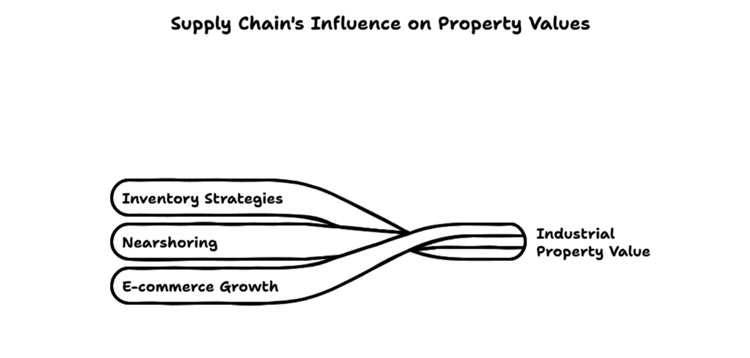The industrial and logistics property game is changing fast. Forget the old rulebook; with e-commerce sales exploding to a projected $6.4 trillion this year alone and companies scrambling to bring production closer to home (nearshoring), supply chains are no longer just a supporting element – they are the show.
Having spent years knee-deep in this stuff, analyzing trends and making data-driven calls, let me tell you: understanding the supply chain isn’t a nice-to-have anymore. It’s essential. Like I had experience with digging into the Fayetteville, NC commercial properties data analytics by Realmo. In this article, I’ll share insights from my real-world experience, explaining how to use industrial property analytics to find hidden value and stay ahead in this cutthroat market.
Key Supply Chain Trends Tipping the Valuation Scales
Several major shifts are reshaping the world of industrial real estate, and they have HUGE implications for property values.
E-commerce, naturally, is still king. You see those delivery vans everywhere, right? That’s because online shopping continues to rocket upwards, according to Statista. This creates a hunger for larger, well-located fulfillment centers that can handle massive volumes and lightning-fast delivery. Think of huge warehouses appearing near city edges.
Then there’s the whole nearshoring and reshoring trend. Companies are waking up to the risks of relying solely on overseas supply chains (hello, geopolitical headaches!). They’re looking to bring manufacturing closer to customers. I saw this firsthand recently when evaluating a portfolio in the Southeast. The valuations jumped because companies were moving operations from Asia to be closer to the US market. The bottom line: shorter supply chains. I expect to see more of this, especially where states offer incentives.
Inventory strategies are also a big deal. Remember “just-in-time” inventory? Well, that’s going out the window. Now it’s all about “just-in-case.” Businesses want resilience over cost, meaning they need more warehouse space to hold safety stock. That’s driving up demand (and prices!) in those critical distribution hubs. Warehouses are also being equipped with automation to improve production. As Michael Landsberg, a commercial real estate analyst, says, “We’re seeing warehouse automation more and more as companies are seeking to improve throughput inside distribution centers”.
Understanding the Interplay: Supply Chains and Industrial Real Estate
Think of the supply chain as the engine driving industrial and logistics property needs. A raw materials warehouse is going to want to be close to the point of production and manufacturing. But a distribution center is going to want to be close the point of consumption to reduce travel costs.
Consider a product’s journey from raw materials to your doorstep. The manufacturer requires space for receiving and shipping materials. Then, the distributor moves the product, and finally the retailer gets it on the market (realnex.com). And the right location of each phase can increase efficiency and lower costs.
Prologis (prologis.com), a major player in logistics real estate, categorizes properties by their role in the modern supply chain, focusing on the consumption end. Whether it’s a giant fulfillment center on the outskirts of a city or a last-mile delivery hub in a dense urban area, each property type is vital. Recognizing these nuances is essential for accurate valuations.
Essential Analytics for Assessing Supply Chain Impacts
To determine how supply chains impact industrial property values, I use a combination of key metrics and reliable data. First, I check market-level vacancy rates and rent growth. Those numbers provide a sense of the overall demand (images1.cityfeet.com) within different industrial submarkets.
However, it’s important to go deeper. I also track transportation infrastructure metrics, like proximity to ports, railways, and highways. Proximity to these hubs will increase the value of the property as they facilitate increased goods movement. On top of this, wages and local skilled labor must be factored in. For data, I use CoStar and CBRE Econometric Advisors for data on comprehensive markets. I also use information from the Bureau of Labor Statistics for labor markets. I have created an Excel tool that also helps find certain trends in the market.
Finally, each region has unique qualities that drive the supply chain. For example, I keep in mind that specialized brokers (supplychainrealestate.com) are a factor in valuing logistics hubs.
Case Studies: Real-World Examples
Let me pull back the curtain and share a couple of examples of how I’ve used supply chain analytics to make investment decisions.
Years ago, I identified an underappreciated portfolio of industrial properties in a secondary market benefiting from a major e-commerce player’s expansion. Traditional valuation said it was fairly priced, but I saw that the e-commerce boom would drive rent growth (restack.io). By factoring in that supply chain info, I predicted the property’s future performance, acquired it at a discount, and made a tidy profit.
On the other hand, I passed on a large distribution center deal near a major port. Looked good at first, but my supply chain analysis showed that the port was suffering from increasing congestion, which would hurt the property’s long-term success (supplychainconnect.com). And that’s why analytics is so important! Analysis has proven to be important in achieving financial objectives (joinleland.com).
Strategies for Adapting to Supply Chain Volatility
Supply chain volatility is the norm, not the exception. So, how can investors and developers thrive?
First, make sure your investments are diversified so that downturns can be offset (supplychainbrain.com). Second, focus on structures that are adaptable. The ability to adapt your structure to different tenants will give you an edge during the downturn. With higher ceilings, flexible floors, and robust technology, your assets will prove to be useful. Finally, you need technology! Technology will let you oversee potential disruptions, as well as avoid unnecessary changes (thebci.org). Here’s a quick checklist to get started:
- Map your supply chain: Record how many tiers you’ve achieved per product (linkedin.com).
- Diversify: Don’t over-rely on a single vendor (thebci.org).
- Plan for disruptions: Understand where potential disruptions might arise (supplychainbrain.com).
Conclusion
As we’ve seen, industrial property valuations must incorporate supply chain analytics. By understanding modern supply chains, monitoring essential metrics, and planning to account for potential risks, you will see an increase in revenue.











